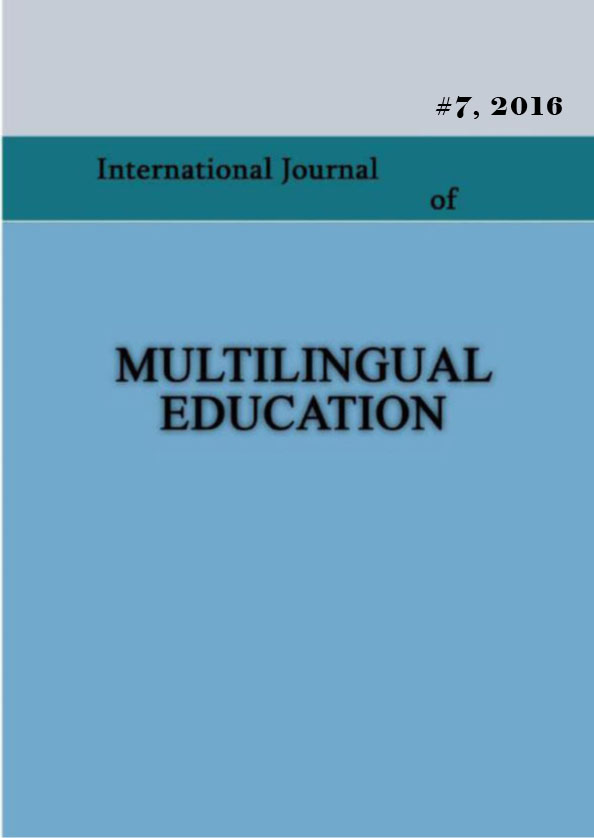Designing the Sequence of Content Acquisition for Science and Language Integrated Learning Programme for Grade 1 Students
Keywords:
science, language, content, integrated learning, CLIL, cross curricula approach, programme design.Abstract
The article deals with the action research of designing the sequence of content acquisition of English and science integrated learning programme to improve learning and engagement of Grade 1 students during their lessons of science in English. The research sample are Grade 1 students learning science in English, the teachers teaching science in English, teachers teaching science according the curriculum, and the English language teachers at Riga Secondary School No.34. Research took place in spring, 2014, and spring, 2015, and lasted for one year.
The process of creating the sequence of content acquisition of English and science integrated learning programme involved the following cycles: the exploration of theoretical background, relevant documents and teachers’ opinions on teaching content and language; the analysis of the course books for teaching science in Latvia and the authentic materials from UK for Grade1 students; designing Programme 1 for integrated English and science learning, piloting the content and materials of Programme 1, defining and introducing the improvements in Programme 2 and evaluation of the Programme 2. The data were collected by questionnaires, interviews, classroom observation and field notes.
Action research provided quantitative and qualitative data for adjusting content, language, instructions and activities to improve student learning. The research helped to see what improvements needed to be introduced for the enhancement of the programme for teaching science and English for Grade 1 students, as well as to eliminate the drawbacks occurred in teaching process. Designing the sequence of content acquisition of integrated language and content programme combines the exploring the students’ interests and the aims of the subject curricula.
References
Baetens-Beardsmore, H. (1997). Manipulating the Variables in Bilingual Education in Buiteveld,
A. Report on the conference on European networks in bilingual education. The Hague: Dutch European Platform.
Coyle, D. (2006). English Perspective for CLIL Research and Practice Matrix. European Commission.
Coyle, D. (2009). Towards an Integrated Curriculum – CLIL National Statement and Guidelines Available in http://www.languagescompany.com/images/stories/docs/news/clil_ national_ statement_and_guidelines.pdf [Accessed 15 May 2015].
Coyle, D. (2011). Teacher Education and CLIL Methods and Tools. Seminar presented in Arisaig, Scotland.
Coyle, D., Hood, P. & Marsh, D. (2010). CLIL: Content and Language Integrated Learning.
Cambridge: Cambridge University Press.
Curtain, H, and Pesola, C.A.B. (1994). Languages and Children: Making the Match New York: Longman.
Dalton-Puffer, C. (2007). Outcomes and Processes in Content and Language Integrated Learning (CLIL) // In: Delanoy, W. & Volkmann, L. Future Perspectives for English Language Teaching (S. 139-157).
DESI-Konsortium (Hrsg.) (2008). Unterricht und Kompetenzerwerb in Deutsch und Englisch.
Ergebnisse der DESI-Studie. Weinheim: Beltz.
Eurydice European Unit. (2006). Content and Language Integrated Learning - CLIL- at School and Europe. http://www.indire.it/lucabas/lkmw_file/eurydice/CLIL_EN.pdf.
Fautley, M. (2013). Lesson Planning for Effective Learning. UK: Open University Press. Gallardo del Puerto, F. (2007). On the Effectiveness of Early Foreign Language Instruction in
School Contexts.// In: Elsner, D., Küster, L., & Viebrock, B. (Eds.), Fremdsprachen- Kompetenzen für ein Wachsendes Europa [Foreign language competence for a growing Europe] (pp. 215–229). Amsterdam: John Benjamins.
Griņevska, I. (2015). Angļu valodas un dabaszinību integrētas programmas izstrāde 1. klases skolēniem/ English and Science Integrated Learning Programme for Grade 1 Students. Maģistra darbs/ Master’s Paper, Latvia: Riga.
Harlen, W. (2010). Principles and Big Ideas of Science Education. UK: College Lane. http://likumi.lv/doc.php?id=145143 [Accessed 21.08.2014].
Kerry, T. (2010). Cross-Curricular Teaching in the Primary School: Planning and Facilitating.
New York: Routledge.
Krashen, S. D. (1989). Language Acquisition and Language Education: Extensions and Applications. New York: Prentice Hall.
Lapinska, I. (2015). CLIL Latvijas valodas agentūras darbības kontekstā.// In: Lazdiņa, S. (ed) CLIL jeb mācību satura un valodas integrēta apguve: izglītības paradigmas maiņa (2015). Latviešu valsts aģentūra.
Lasagabaster, D. (2008). Foreign Language Competence in Content and Language Integrated Courses. The Open Applied Linguistics Journal, 1, 30–41.
Lightbown, P. M. and Spada, N. (2013). How Languages Are Learned 4th edition. Oxford University Press.
Marsh, D. (1994). Bilingual Education & Content and Language Integrated Learning. Paris: International Association for Cross-cultural Communication, Language Teaching in the Member States of the European Union, University of Sorbonne.
Marsh, D. and Mehisto, P. (2009). CLIL Practice: Perspectives from the Field.
Finland: CCN, University of Jyväskylä.
Master, P. (1997/8). Content-based Instruction vs. ESP. TESOL Matters, 6, 10. Mohan, B. (1986). Language and Content. Reading. MA: Addison-Wesley.
Programma (2006). Valsts valodas politikas programma 2006.-2010. gadam. Latvijas Republikas Ministru kabineta noteikumi Nr. 770, 2010. 4. 10. Available in
Rampone, S. (2010). Strategies for CLIL. Available in https://www.google.lv
/url?sa=t&rct=j&q=&esrc=s&source=web&cd=3&cad=rja&uact=8&ved=0CDsQFj AC&url=http%3A%2F%2Fshare.dschola.it%2Fdd4pinerolo%2Fclimate%2FShared% 2520Documents%2Fb.%2520CLIMATES_CLIL.doc&ei=V7CUU_LqHOuBywP3k4HA CA&usg=AFQjCNEsLDFUlbFBBlYZMjQwAqmM9evinw&sig2=mMrTTFU_iLKT3uzL H8foGQ [Accessed 8 January 2015].
Snow, M.A. (1990). Instructional Methodology in Immersion Foreign Language Education.// In: Fairchild, H. H., Padilla, A. M., & Valadez, C. M. (Eds.). (1990). Foreign Language Education: Issues and Strategies. Sage Publications.
Stoller, F. L. (2004). Content-based Instruction: Perspectives on Curriculum Planning. Annual Review of Applied Linguistics, Volume 24, 261-283.
http://journals.cambridge.org/action/displayAbstract?fromPage=online&aid=223408&fi leId=S0267190504000108
Vaivade, V. (2015). CLIL pieejas pedagoģiski aspekti: mēķi, uzdevumi un īstenošana. // In: Lazdiņa, S. (ed) CLIL jeb mācību satura un valodas integrēta apguve: izglītības paradigmas maiņa. (2015). Latviešu valsts aģentūra.
Wayne D. G. (2007). Integrated Models of Cognitive Systems. New York: Oxford University Press.
Wolff, D. (2007). CLIL: Bridging the Gap Between School and Working Life. 15-25. // In: Marsh, D., & Wolff, D. (2007). Diverse Contexts-Converging Goals. CLIL in Europe. Frankfurt: Peter Lang.
Published
How to Cite
Issue
Section
License

This work is licensed under a Creative Commons Attribution-ShareAlike 4.0 International License.

